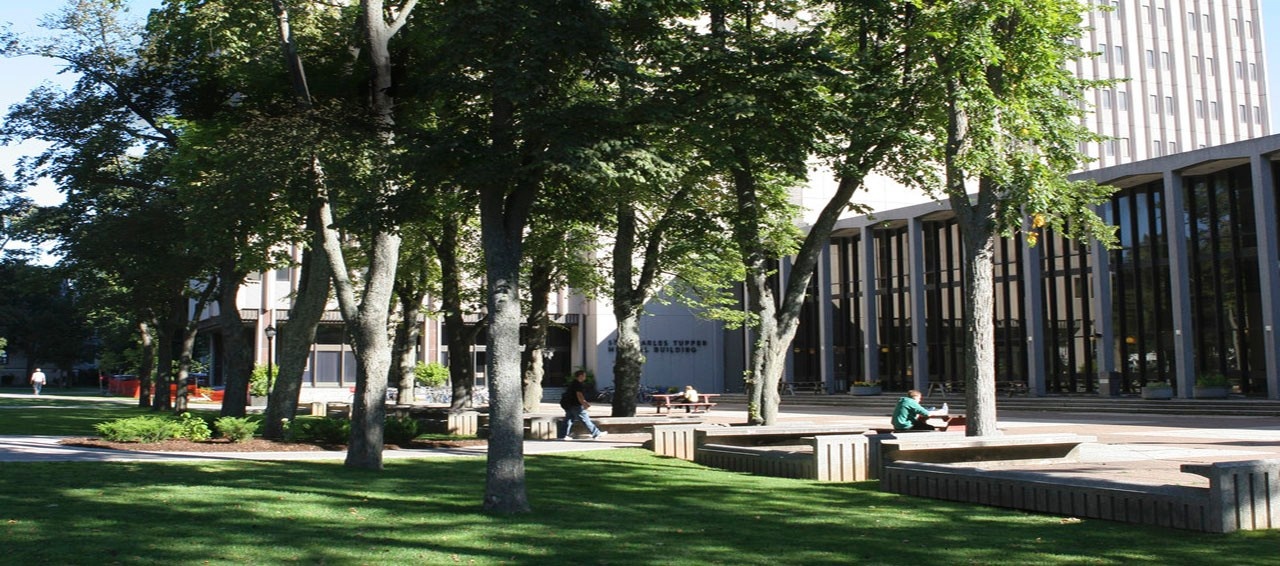» Go to news main
Entering the Den for a research prize

Photo credit: Saint John Regional Hospital Foundation
The winning team presented their case using a skit of a physician who has an Angel on one shoulder urging the use of known methodology and the Devil on the other shoulder suggesting he try something new. Pictured from left to right: Dr. Jean-François Légaré (aka “The Angel”), Scott McCain, Hon. Anne McLellan, Dr. David Elias, Steve Douglas, Dr. Keith Brunt (aka “The Devil”), and Dr. Sohrab Lutchmedial (aka “The Doctor”).
“Scary but fun,” is how Dr. Keith Brunt, researcher and associate professor in the Department of Pharmacology at Dalhousie Medicine New Brunswick (DMNB), describes his experience winning $500,000 this past weekend with his IMPART team.
IMPART is a group of clinicians, scientists and researchers based out of DMNB who are studying the effects of co-morbidity. Their goal is to provide health care teams with decision-making tools that will help them to assemble the most appropriate teams of specialists to meet patient needs, to provide truly patient-centred care.
A new kind of Dragon’s Den
When you mention “Dragon’s Den,” an image of savvy venture capitalists putting up money to help budding entrepreneurs launch their ideas comes to mind. This past weekend that image was redefined.
The Saint John Regional Hospital Foundation hosted its own “Medical Dragon’s Den” in which teams of clinical researchers and health care providers pitched their projects to a team of “venture philanthropists” comprised of Hon. Anne McLellan (Dalhousie University’s Chancellor), Dr. David Elias, Steve Douglas and Scott McCain. The winning team walked away with half a million dollars to finance its project. This format of investing in research focuses the return on investment in social capital instead of financial.
The IMPART team, comprised of DMNB faculty members—Dr. Brunt, Dr. Sorab Lutchmedial, an interventional cardiologist at the Saint John Regional Hospital, and Dr. Jean-François Légaré, head of cardiac surgery at the Saint John Regional Hospital—pitched the purchase of a Nobel-prize winning super-resolution microscope to the Dragons. This microscope would be the first of its kind in Canada dedicated to clinical research.
Their business case highlighted the impact of the microscope on their research, the impact on patients and the impact on the economy from such an investment.
Impacts
Having the microscope locally will help Dr. Brunt and the IMPART team track and trace new medicines to ensure they will have the desired effect on specific patients. This can lead to decreased hospital stays, and increased savings for the government.
Co-morbidity, the presence of multiple chronic conditions at the same time in a single patient, is on the rise. For example, one patient could have diabetes, high-blood pressure, a mobility issue and a mental health problem, each presenting its own challenges and the possibility of medication interactions, miscommunication among providers, confusion for the patient, and complications of improperly managed risk factors and symptoms.
“Presently the most vulnerable of the patient population—approximately 20 per cent—take up 80 per cent of the costs,” states Dr. Brunt, noting that such patients are often older, possibly frail, and very complex and expensive to manage.
By equipping the IMPART team with such a powerful microscope, “We can begin building strategies focused around the linked systems of the various diseases,” explains Dr. Brunt. This can lead to improved outcomes, reduced side effects and improved quality of life for the patient.
A component of the business case for the IMPART team was the potential for leveraging the investment made by the Dragons for future funding. Many funding agencies like to see what other forms of funding have been received for a project. This gives the IMPART team an opportunity to apply successfully for more funds.
“Work now has to follow through. This is the beginning of something bigger. We hope this will be the keystone for raising $5 million in partnerships and leveraging.”
What’s next
Along with applying for more funding, the microscope will be purchased and installed. The group hopes to set it up in the DMNB translational research lab located in the Saint John Regional Hospital by the fall of 2018.
When asked if he would do it again, Dr. Brunt’s response was, “Yes, I would do it again and I encourage others to do it. We [as researchers] need to communicate what we do in more innovative ways.” He credits the Saint John Regional Hospital Foundation for giving him the opportunity to directly interact with the donors, so they could see the uncertainty but more importantly the possibilities of the research projects presented.
Recent News
- Dalhousie’s first physician assistant cohort steps into Nova Scotia’s healthcare system
- Dalhousie med students explore pediatric care in Austria
- Dalhousie researchers shine at Discovery Awards with four top honours
- New $2M national study to uncover how biology, social factors shape MS outcomes
- Pathology EDIA Committee makes strides during 2024‑2025 year
- CCfV’s impact on vaccine innovation
- Unlocking the secrets of memory—with fruit flies
- Celebrating mobility research and the power of philanthropy
